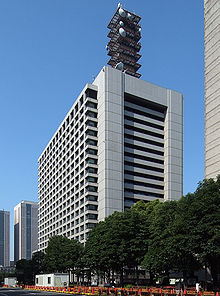National Police Agency (Japan)
| National Police Agency 警察庁 Keisatsu-chō | |
|---|---|
 | |
 The Kyokujitsushou | |
| Abbreviation | NPA |
| Agency overview | |
| Formed | July 1, 1954 |
| Preceding agency |
|
| Employees | 7,995 (2020)[1] |
| Annual budget | ¥360.348 billion (2020)[2] |
| Legal personality | Law enforcement agency |
| Jurisdictional structure | |
| National agency | Japan |
| Operations jurisdiction | Japan |
| Operational structure | |
| Headquarters | 2-1-2 Kasumigaseki, Chiyoda, Tokyo 100-8974, Japan |
| Civilians | 4,800 |
| Agency executive |
|
| Parent agency | National Public Safety Commission |
| Child agencies |
|
| Bureaus | 5
|
| Regional Bureaus | 6
|
| Website | |
| www.npa.go.jp/english/index.html (in English) www.npa.go.jp (in Japanese) | |
| [3] | |

The National Police Agency (警察庁, Keisatsu-chō) is the central coordinating law enforcement agency of the Japanese police system. Unlike national police in other countries, the NPA does not have any operational units of its own aside from the Imperial Guard; rather, it is responsible for supervising Japan's 47 prefectural police departments and determining their general standards and policies, though it can command police agencies under it in national emergencies or large-scale disasters. It is under the National Public Safety Commission of the Cabinet Office.[4]
As of 2017, the NPA has a strength of approximately 7,800 personnel: 2,100 sworn officers, 900 guards, and 4,800 civilian staff.[5]
History[edit]
Police services of the Empire of Japan were placed under complete centralized control with the Police Affairs Bureau (警保局, Keiho-kyoku) of the Home Ministry at their core. But after the surrender of Japan, the Supreme Commander for the Allied Powers regarded this centralized police system as undemocratic.[6]
During the occupation, the principle of decentralization was introduced by the 1947 Police Law. Cities and large towns had their own municipal police services (自治体警察, Jichitai Keisatsu), and the National Rural Police (国家地方警察, Kokka Chihō Keisatsu) was responsible for smaller towns, villages and rural areas. But most Japanese municipalities were too small to have a large police force, so sometimes they were unable to deal with large-scale violence. In addition, excessive fragmentation of the police organization reduced the efficiency of police activities.[6]
As a response to these problems, complete restructuring created a more centralized system under the 1954 amended Police Law. All operational units except for the Imperial Guard were reorganized into prefectural police for each prefecture, and the National Police Agency was established as the central coordinating agency for these Police Departments.[6]
On April 1, 2022, the NPA created the Cyber Affairs Bureau and the National Cyber Unit.[7] On December 2023, the NPA announced that the TAIT (Telecom Scam Allianced Investigation Team) will be established on April 2024 to unify investigation efforts across Japan on fraud cases.[8]
Organization[edit]
Leadership[edit]
The Commissioner General of the National Police Agency (警察庁長官, Keisatsu-chō Chōkan) is the highest ranking police officer of Japan, regarded as an exception to the regular class structure. For the Deputy Commissioner General (次長, Jichō), the Senior Commissioner is supplemented. The Commissioner General's Secretariat (長官官房, Chōkan Kanbō) are their staff. The civilian political leadership is provided by the National Public Safety Commission.[6]
Internal Bureaus[edit]
Community Safety Bureau[edit]
The Community Safety Bureau (生活安全局, Seikatsu Anzen-kyoku) is responsible for crime prevention, combating juvenile delinquency, and pollution control.[9]
This bureau was derived from the Safety Division of the Criminal Affairs Bureau in 1994.[10]
- Community Safety Planning Division (生活安全企画課)
- Community Police Affairs Division (地域課)
- Juvenile Division (少年課)
- Safety Division (保安課)
- Cybercrime Division (情報技術犯罪対策課)
- Director for Economic Crimes Investigation (生活経済対策管理官)
Criminal Affairs Bureau[edit]
The Criminal Affairs Bureau (刑事局, Keiji-kyoku) is in charge of research statistics and coordination of the criminal investigation of nationally important and international cases.[9]
- (Direct reporting divisions)
- Criminal Affairs Planning Division (刑事企画課)
- First Investigation Division (捜査第一課)
- Second Investigation Division (捜査第二課)
- Director for Criminal Intelligence Support (捜査支援分析管理官)
- Director for Criminal Identification (犯罪鑑識官)
- Organized Crime Department (組織犯罪対策部)
- Organized Crime Policy Planning Division (組織犯罪対策企画課)
- Japanese Organized Crime Division (暴力団対策課)
- Drugs and Firearms Division (薬物銃器対策課)
- Director for International Investigative Operations (国際捜査管理官)
Traffic Bureau[edit]
The Traffic Bureau (交通局, Kōtsū-kyoku) is responsible for traffic policing and regulations. This bureau was derived from the Safety Bureau (保安局, Hoan-kyoku) (later merged with the Criminal Affairs Bureau; predecessor of the Community Safety Bureau) in 1962 because of the expression indicating a high number of deaths from traffic accidents.[6][9]
- Traffic Planning Division (交通企画課)
- Traffic Enforcement Division (交通指導課)
- Traffic Management and Control Division (交通規制課)
- License Division (運転免許課)
Security Bureau[edit]
The Security Bureau (警備局, Keibi-kyoku) is in charge of the internal security affairs, such as counter-intelligence, counter-terrorism or disaster response.[6][9]
- (Direct reporting divisions)
- Security Planning Division (警備企画課)
- Public Security Division (公安課)
- Security Division (警備課)
- Foreign Affairs and Intelligence Department (外事情報部)
- Foreign Affairs Division (外事課)
- Counter International Terrorism Division (国際テロリズム対策課)
After the 1996 Japanese embassy hostage crisis in Peru, the Security Bureau established the Terrorism Response Team where officers liaise with foreign law enforcement and intelligence agencies when Japanese interests or nationals are in danger.[11] It was later reformed to the Terrorism Response Team - Tactical Wing (TRT-2) for Overseas in order to meet with demands to coordinate with foreign police forces in assisting them whenever a terror attack has happened.[11]
Info-Communications Bureau[edit]
The Info-Communications Bureau (情報通信局, Jōhō Tsūshin-kyoku) supervises police communications systems and combat with cyberterrorism.
- Info-Communications Planning Division (情報通信企画課)
- Information Systems Division (情報管理課)
- Communications Facilities Division (通信施設課)
- High-Tech Crime Technology Division (情報技術解析課)
Local Branch Bureaus and Departments[edit]
Regional Police Bureaus[edit]
There are six Regional Police Bureaus (管区警察局), each responsible for a number of prefectures as below:[12]
- Tōhoku Regional Police Bureau (東北管区警察局, Tōhoku Kanku Keisatsu-kyoku)
- Aomori, Iwate, Miyagi, Akita, Yamagata, and Fukushima Prefectures
- Kantō Regional Police Bureau (関東管区警察局, Kantō Kanku Keisatsu-kyoku)
- Ibaraki, Tochigi, Gunma, Saitama, Chiba, Kanagawa, Niigata, Yamanashi, Nagano, and Shizuoka Prefectures
- Chūbu Regional Police Bureau (中部管区警察局, Chūbu Kanku Keisatsu-kyoku)
- Toyama, Ishikawa, Fukui, Gifu, Aichi, and Mie Prefectures
- Kinki Regional Police Bureau (近畿管区警察局, Kinki Kanku Keisatsu-kyoku)
- Shiga, Kyoto, Osaka, Hyogo, Nara, and Wakayama Prefectures
- Chūgoku–Shikoku Regional Police Bureau (中国四国管区警察局, Chūgoku Shikoku Kanku Keisatsu-kyoku)
- Tottori, Shimane, Okayama, Hiroshima, and Yamaguchi Prefectures
- Tokushima, Kagawa, Ehime, and Kochi Prefectures
- Kyūshū Regional Police Bureau (九州管区警察局, Kyūshū Kanku Keisatsu-kyoku)
- Fukuoka, Saga, Nagasaki, Kumamoto, Oita, Miyazaki, Kagoshima, and Okinawa Prefectures
They are located in major cities of each geographic region. The Tokyo Metropolitan Police Department and Hokkaido Prefectural Police Headquarters are excluded from the jurisdiction of regional police bureaus. Headed by a Senior Commissioner, each regional police bureaus exercises necessary control and supervision over and provides support services to prefectural police within its jurisdiction, under the authority and orders of NPA's Commissioner General. Attached to each Regional Police Bureaus is a Regional Police School which provides police personnel with education and training required of staff officers as well as other necessary education and training.
Police Communications Departments[edit]
Metropolitan Tokyo and the island of Hokkaidō are excluded from the regional jurisdictions and are run more autonomously than other local forces, in the case of Tokyo, because of its special urban situation, and of Hokkaidō, because of its distinctive geography. The National Police Agency maintains police communications divisions in these two areas to handle any coordination needed between national and local forces. In other area, Police Communications Departments are established within each Regional Police Bureaus.
- Independent Communications Departments
- Tokyo Metropolitan Police Info-Communications Department (東京都警察情報通信部, Tōkyō-to Keisatsu Jōhō Tsūshin-bu)
- Hokkaido Police Info-Communications Department (北海道警察通信情報部, Hokkaidō Keisatsu Tsūshin Jōhō-bu)
Subsidiary Organs[edit]
- National Police Academy (警察大学校, Keisatsu Dai-gakkō)
- National Research Institute of Police Science (科学警察研究所, Kagaku Keisatsu Kenkyū-sho)
- Imperial Guard Headquarters (皇宮警察本部, Kōgū-Keisatsu Honbu)
See also[edit]
- Police services of the Empire of Japan
- Law enforcement in Japan
- Public order and internal security in Japan
- Fire and Disaster Management Agency
References[edit]
- ^ 行政機関職員定員令(昭和44年5月16日政令第121号)(最終改正、令和2年3月30日政令第75号) - e-Gov法令検索
- ^ 令和2年度一般会計予算 財務省
- ^ "Police of Japan". National Police Agency. Archived from the original on 2008-02-22. Retrieved 2008-08-06.
- ^ Police of Japan, National Police Agency. "POLICE OF JAPAN - NATIONAL POLICE AGENCY | Office of Justice Programs". www.ojp.gov. Retrieved 19 May 2022.
- ^ National Police Agency (2018). POLICE OF JAPAN 2018 (Overview of Japanese Police) (PDF) (Report). Archived (PDF) from the original on 2019-04-07. Retrieved 2019-04-07.
- ^ a b c d e f National Police Agency Police History Compilation Committee, ed. (1977). Japan post-war police history (in Japanese). Japan Police Support Association.
- ^ "Japan makes progress on international cyber probe collaboration". 4 September 2023.
- ^ "Police to Set up Special Fraud Investigation Team". 14 December 2023.
- ^ a b c d National Police Agency. "Mechanism of Police systems" (in Japanese). Archived from the original on 2012-12-06. Retrieved 2016-11-07.
- ^ Japan Federation of Bar Associations. "Declaration on police activities and citizens' human rights" (in Japanese). Archived from the original on 2016-11-15. Retrieved 2016-11-08.
- ^ a b "Archived copy" (PDF). Archived (PDF) from the original on 2011-03-23. Retrieved 2011-03-26.
{{cite web}}: CS1 maint: archived copy as title (link) - ^ "Public Safety Commission System and Police Activity Support" (PDF). Japanese National Police Agency. Archived from the original (PDF) on 2012-04-20. Retrieved 2012-02-15.
External links[edit]
- Official website (in Japanese)
- Official website (in English)
- National Police Agency on Twitter


 French
French Deutsch
Deutsch